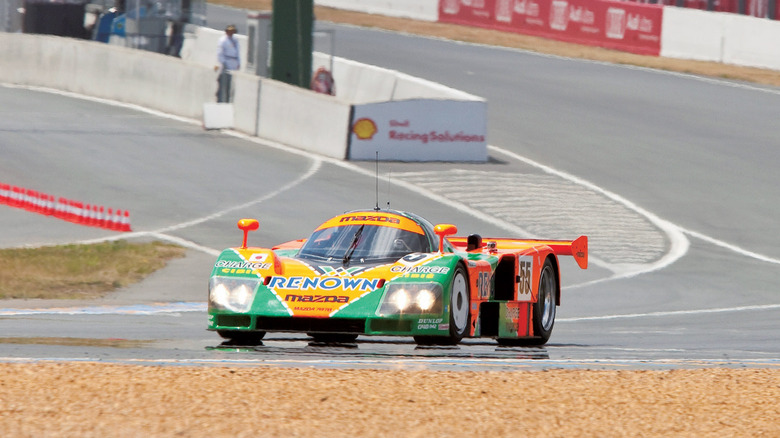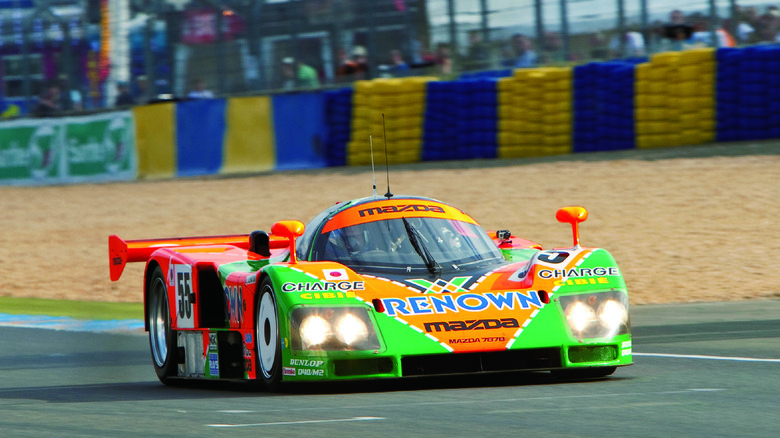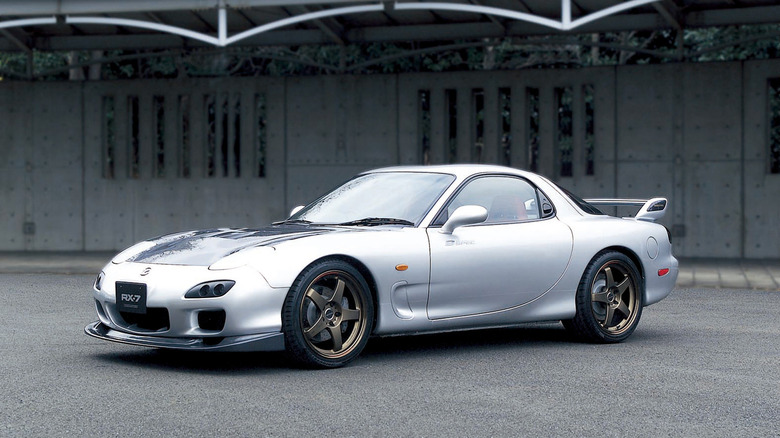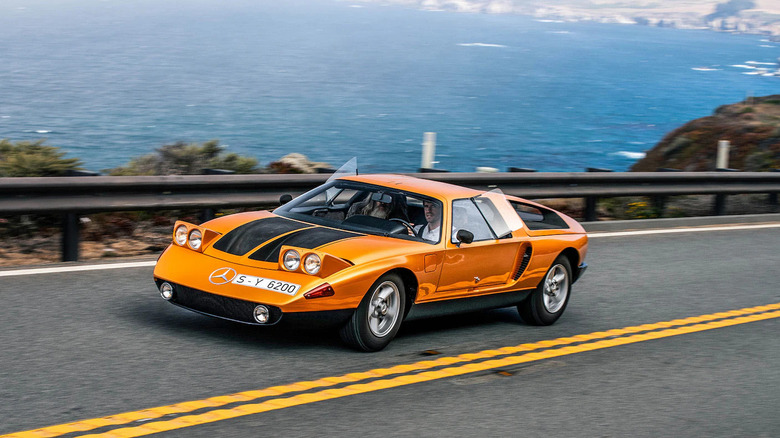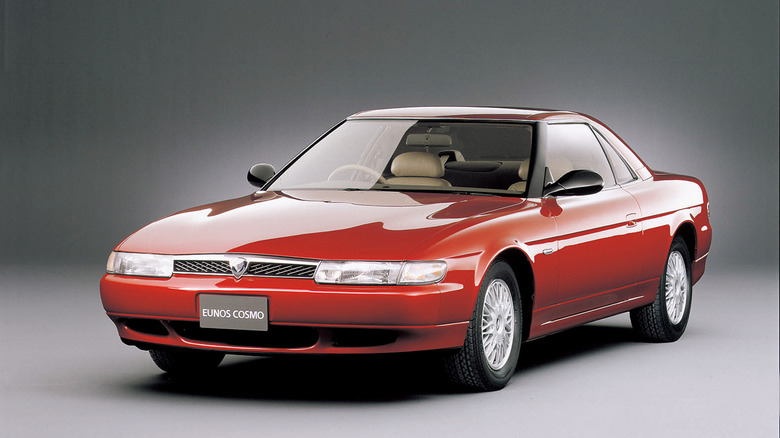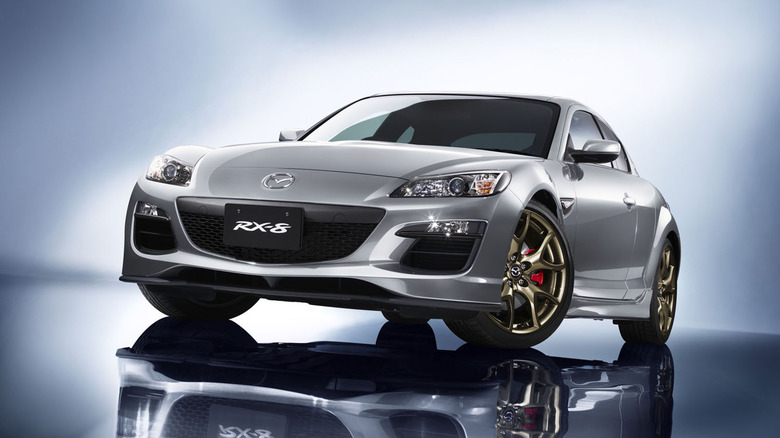5 Of The Best Rotary Engine Cars Ever Built
Almost every internal combustion vehicle on the planet today uses the classic piston engine. These run by converting heat energy into reciprocating motion, and then rotary motion that ultimately powers the wheels through the drivetrain. But what if you could produce a rotary motion directly from combustion? That was the dream of Dr. Felix Wankel, who, after working on the design for more than 30 years, created the world's first rotary engine in collaboration with German motorcycle and automobile manufacturer, NSU.
The Wankel rotary was a very promising engine. The German Nazi regime saw it as a competitive advantage over its rivals, with Wankel being a member of the party. And after the war, most automakers licensed Wankel's patent, as they believed the design would disrupt the industry. The engine had fewer moving parts, meaning — at least in theory — better reliability. It could also rev more freely and extract much more power from very small capacities. The compact size and low weight made it especially interesting for sports cars.
Still, most automakers quickly abandoned the Wankel rotary due to poor reliability, high fuel/oil consumption, and low torque. Fortunately, Mazda continued to push the boundaries of the design and gave us many memorable Wankel-powered automobiles. And in this piece, we'll celebrate five of the best rotary engine cars ever built, in no particular order. Oh, and not all are Mazdas!
Mazda 787B (1990-1991)
Mazda engineers had to hear all sorts of bad things about rotary engines in the 1980s. They were hungry for fuel and oil. They produced almost no torque. Bad reliability was used almost like the boogeyman to swerve buyers away from these engines. Then Mazda proved everyone wrong with the 787B race car, which won the 1991 24 Hours of Le Mans.
Powered by a high-revving four-rotor powertrain, the Mazda 787B not only survived Le Mans, but completely outclassed its rivals. And we're not talking about ordinary competition, either. The legendary Peugeot 905 powered by a 3.5-liter, F1-derived V10 was on the field that day. 7.4-liter V8s Jaguars. 5.0-liter V8 Mercs. Even the already established Porsche 962C was there.
The 787B didn't win with speed. In fact, the screaming 787Bs qualified at 12th and 17th place. It was the rotary's excellent reliability, low 1,830-pound curb weight, and good fuel efficiency, that let it slowly climb the ladder. The Mazda 787B finished two laps ahead of the Jaguar XJR-12 LM, becoming the first Japanese car to win the race.
Of course, the 2.6-liter four-rotor engine could still be tuned to 900 hp at 10,000 rpm, but Mazda cleverly kept it at 700 hp and 9,000 rpm for maximum reliability. The powertrain also had three-plug ignition and linear variable air intake system for efficient combustion and ceramic apex seals for durability. Unfortunately, rotary engines were banned for 1992, killing 787B's dreams of further glory.
Mazda RX-7 FD (1992-2002)
While the four-rotor race engine was more impressive, the RX-7's 1.3-liter twin-rotor twin-turbo pushed Mazda's road car game to new heights. The sequential twin-turbo setup helped with the low-end torque and gave the 13B-REW unit 255 hp. Far from impressive by today's standards, but still enough for a 0-60 time of 5.2 seconds. Much like the MX-5 Miata, the RX-7 was featherlight at just 2,789 pounds, which helped it reach its 156 mph top speed.
However, the RX-7 FD wasn't a legend just because of its numbers — Look at it! Put some modern LED lighting on that swoopy, aerodynamic body, and you could launch it as a brand-new model. It's low slung and elegant, easily one of Japan's best car designs. The same can be said for the driving experience.
Balanced, agile, and with quick reflexes, the FD is an antidote to today's sports-car tanks. It featured a precise five-speed manual. Its 8,000-rpm redline enabled an ear-piercing racecar-like noise. The car had an ideal 50-50 weight distribution, with a RWD configuration and a limited-slip differential.
All these make it perhaps the best bone-stock car south of a Ferrari or a Porsche, but way more exotic. No other car has ever combined timeless looks with low weight and a twin-rotor, twin-turbo engine. The RX-7 FD is easily one of the most iconic cars in JDM history, and arguably the GOAT among rotary engine cars.
Mercedes-Benz C111 (1969-1970)
1970 may have been the year when American muscle cars reached their pinnacle, but Mercedes-Benz was heading in a completely different direction with its futuristic C111. Wedge-shaped, low, and wide, the C111 caused quite a stir among the public. Unfortunately, a production model never reached showrooms; instead, Mercedes-Benz used it as a rolling lab for advanced propulsion methods. Sure, the futuristic design and gullwing doors made headlines, but it was the engine under the hood that made the Mercedes-Benz C111 special.
Initially, the prototype supercar was equipped with a three-rotor Wankel rotary engine with fuel injection, good for 275 hp. However, Merc's engineers upped the ante and put a four-rotor, 350-hp engine in the middle — enough for a theoretical top speed of 186 mph, according to the company. The 0-62 mph acceleration also apparently took just 4.8 seconds. In 1970, this was science fiction.
The rest of the C111 was also exotic. It had a multilink rear suspension. Tube-style welded frame. ABS. A lightweight, fiberglass body. It was all molded into a beautiful, aerodynamic shape with a low drag coefficient of 0.33 Cd. If it had reached production, it would've definitely messed up Ferrari's accounts. Still, the Mercedes-Benz top brass voted against a production version, deeming the rotary engine too thirsty and fragile. If only Mercdees had the persistence of Mazda, the C111 could've been even more legendary than the 300 SL.
Eunos Cosmo JC (1990-1996)
Want some Mazda Wankel magic, in a more elegant, grand tourer body? The stunning fourth-gen JDM-only Eunos Cosmo JC was low, sleek, and classy. It still looks fresh to this day, and its wraparound interior dressed in premium materials is even more impressive. Cosmo's futuristic credentials were further emphasized by the full-color infotainment touchscreen with GPS navigation and built-in TV, the first of its kind in a production car. You could even cover the screen for a cleaner dashboard, a feature that many luxury makers copied later. Imagine the awe of car enthusiasts when they saw it in 1990!
Peek under the low hood, and the Cosmo becomes even more jaw-dropping. It was available with a 1.3-liter two-rotor and a 2.0-liter three-rotor, both equipped with a sequential twin-turbo system designed to kill turbo lag. The smaller engine produced 230 hp and 216 lb-ft, while the larger was good for 276 hp and 296 lb-ft of torque. Still, Mazda had to artificially limit the three-rotor due to the Japanese automaker's gentlemen's agreement — the real figure was probably closer to 320 hp.
Unfortunately, the Cosmo was only available with a four-speed automatic, which crippled the performance. 0-62 mph arrived in 6.2 seconds — not bad for a luxury-oriented grand tourer. Indeed, Mazda's Eunos sub-brand was launched as a luxury marque. Fortunately, manual swaps are a thing in the Cosmo universe, giving Mazda's grand tourer the much-needed driver involvement.
Mazda RX-8 (2003-2011)
If the notion of a turbocharged engine in a lightweight sports car upsets you, don't worry — Mazda also made a great naturally aspirated rotary sports car. The RX-8 isn't just a fun machine, it's also very practical. See, Mazda incorporated two additional doors for the rear seats, which you could only open after opening the front doors. These half-doors are important, because the back seats are actually comfortable. Even the trunk is surprisingly roomy.
The rotary here was all about the revs — the most potent 238-hp version had a 9,000-rpm redline! The fact that the Renesis engine extracted that much power from a capacity of just 1.3 liters is also impressive, as is the 0-60 sprint of 5.9 seconds. The low torque output made this naturally aspirated rotary a bit top-heavy, though as it delivered only 159 lb-ft of torque at high 5,500 rpm. Still, revving this smooth two-rotor engine is a pleasure in itself. There was also a four-speed auto version with 197 hp and a lower 7,500-rpm redline, but a higher 164 lb-ft of torque. Still, we would always recommend the precise, mechanical stick shift.
Unfortunately, Mazda was forced to discontinue the RX-8 due to high emissions and high fuel consumption. The RX-8 rotary was also not as good as RX-7's when it comes to reliability, though some owners claim it's the other way around.
